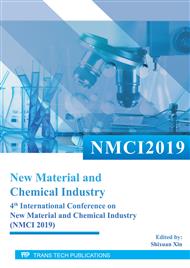[1]
J Lu, C Xu, L Cheng, N Jia, J Huang, C Li, Acetone sensor based on WO3 nanocrystallines with oxygen defects for low concentration detection, Mat. Sci. Semicon. Proc. 101 (2019) 214-222.
DOI: 10.1016/j.mssp.2019.05.038
Google Scholar
[2]
H Liu, F Qu, H Gong, H Jiang, M Yang, Template-free synthesis of In2O3 nanoparticles and their acetone sensing properties, Mater. Lett. 182 (2016) 340-343.
DOI: 10.1016/j.matlet.2016.07.064
Google Scholar
[3]
G Bai, H Dai, J Deng, Y Liu, K Ji, Porous NiO nanoflowers and nanourchins: Highly active catalysts for toluene combustion, Catal. Commun. 27 (2012) 148-153.
DOI: 10.1016/j.catcom.2012.07.008
Google Scholar
[4]
W Tang, Y Deng, W Li, S Li, X Wu, Y Chen, Restrictive nanoreactor for growth of transition metal oxides (MnO2, Co3O4, NiO) nanocrystal with enhanced catalytic oxidation activity, Catal. Commun. 72 (2015) 165-169.
DOI: 10.1016/j.catcom.2015.09.034
Google Scholar
[5]
H Wang, W Guo, Z Jiang, R Yang, Z Jiang, Y Pan, W Shangguan, New insight into the enhanced activity of ordered mesoporous nickel oxide in formaldehyde catalytic oxidation reactions, J. Catal. 361 (2018) 370-383.
DOI: 10.1016/j.jcat.2018.02.023
Google Scholar
[6]
C Dong, X Xiao, G Chen, H Guan, Y Wang, I Djerdj, Porous NiO nanosheets self-grown on alumina tube using a novel flash synthesis and their gas sensing properties, RSC Adv. 5 (2015) 4880-4885.
DOI: 10.1039/c4ra13025a
Google Scholar
[7]
C-Y Lee, C-M Chiang, Y-H Wang, R-H Ma, A self-heating gas sensor with integrated NiO thin-film for formaldehyde detection, Sensor. Actuat. B-Chem. 122 (2007) 503-510.
DOI: 10.1016/j.snb.2006.06.018
Google Scholar
[8]
G Zhu, C Xi, H Xu, D Zheng, Y Liu, X Xu, X Shen, Hierarchical NiO hollow microspheres assembled from nanosheet-stacked nanoparticles and their application in a gas sensor, RSC Adv. 2 (2012) 4236-4241.
DOI: 10.1039/c2ra01307j
Google Scholar
[9]
A. Bielański, M. Najbar, Adsorption species of oxygen on the surfaces of transition metal oxides, J. Catal. 25 (1972) 398-406.
Google Scholar
[10]
Y Lu, Y Ma, S Ma, W Jin, S Yan, X Xu, X Jiang, T Wang, H Yang, H Chen, Z Qiang, Synthesis of cactus-like NiO nanostructure and their gas-sensing properties, Mater. Lett. 164 (2016) 48-52.
DOI: 10.1016/j.matlet.2015.10.117
Google Scholar
[11]
B Liu, H Yang, H Zhao, L An, L Zhang, R Shi, L Wang, L Bao, Y Chen, Synthesis and enhanced gas-sensing properties of ultralong NiO nanowires assembled with NiO nanocrystals, Sensor. Actuat. B-Chem. 156 (2011) 251-262.
DOI: 10.1016/j.snb.2011.04.028
Google Scholar


